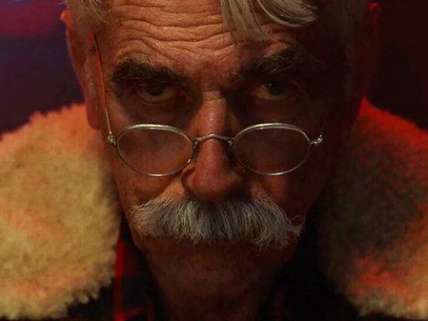Movie Reviews: Lords of Chaos and The Man Who Killed Hitler and Then the Bigfoot
Black-metal murder boys and a failed Sam Elliott fable.

You might say Jonas Åkerlund's Lords of Chaos is attempting to do for the Norwegian black-metal scene of the late 1980s and early '90s what Almost Famous did for the classic-rock world of the 1970s. If so, it fails, but mostly because the music connected to this story has so little popular resonance outside of its doomy subculture. The movie does have Emory Cohen playing black-metal murder boy Varg Vikernes, however, and his creepy performance—half sultry, half sinister—is magnetic.
The picture is like a teen-delinquent b-movie from the 1950s, only with more death, more blood, and more church-burnings. Also with the rare sight of crazed black-metal concert-goers chewing on a raw pig's head that's been tossed into their midst. Okay, it's actually not like Almost Famous at all.
Åkerlund, a longtime maker of hit videos for Madonna, Metallica, Taylor Swift and Lady Gaga, spent a part of his own wasted youth as the original drummer for the proto-black-metal Swedish band Bathory, and he sees the characters here for who they really are—not the hell lords of their dark dreams, but bored middle class kids working up Satanic riffs in their parents' basement and roping mom and dad into paying for their Marshall amps and their recording sessions.
The story is narrated by Øystein Aarseth (Rory Kulkin)—better known by his nom de noir Euronymous – the leader of a black-metal band called Mayhem. When their singer quits, Euronymous receives a letter from an aspiring replacement who calls himself Dead (a terrific Jack Kilmer). Inside the envelope is a dead rat nailed onto a little wooden cross. Perfect. Dead is a piece of work (he keeps his stage clothes buried in the ground between gigs), but he's also the immortal star of a great black-metal anecdote. One night, alone in the country house in which the band was living, Dead ended another evening of slicing at his arms with a knife by hoisting a shotgun and blowing his skull in. Euronymus discovered the body (and the suicide note: "Excuse all the blood. Let the party begin"). But instead of calling the police right away, he drove off to a store to buy a cheap camera, returned to the suicide scene, arranged the gun and the knife more photogenically, snapped a pic—and later used it for a Mayhem album cover. Let no one question this man's commitment to promo.
The Mayhem lads are losers of a familiar nitwit sort, but their Tinkertoy nihilism withers in the presence of the true depravity of Varg Vikernes, who becomes the band's new bass player. Varg gives off heavy neo-Nazi vibes and a dead-eyed anticlericalism. ("Our people are brainwashed with empathy and solidarity and the church."). As a crackpot hobby, he likes to burn down the wooden "stave" churches that are a part of Norway's medieval cultural heritage, and eventually he shames Euronymous into joining him on one of these sorties. Upon reflection, Euronymous realizes that he doesn't enjoy standing quite this close to the flames of evil, and soon he severs his connection with Varg (who also has a one-man-band death metal project called Burzum, whose music is released on Euronymous' record label, Deathlike Silence).
The movie becomes fairly bloody in its second half, first with the stabbing murder of a gay man by a black-metal cretin called Faust (Valter Skarsgård—yes, another Skarsgård brother), and then with the final confrontation between Euronymous and Varg, a gore ballet that stumbles around an apartment and then down a flight of steps before Euronymous collapses in a puddle and gives his final twitch.
None of this story carries much cultural weight, especially at so many years' distance, and so the movie is in most ways an empty (although well-crafted, and not uninteresting) exercise. Although Euronymous is long gone, Mayhem soldiers on, and there's even a North American black-metal tour—featuring the esteemed Dark Funeral—kicking off in San Diego on May 17th. As for Varg Vikernes, he served 15 of the 21 years of prison time to which he was sentenced for killing Euronymous, and has since become an Internet windbag muttering away about paganism and blood-and-soil and all that kind of thing. He's a vivid example of the banality of evil, especially when he's blithely chatting about how he killed his onetime friend. As he does right here.
The Man Who Killed Hitler and Then the Bigfoot

If you're going to make a movie called The Man Who Killed Hitler and Then the Bigfoot – which, as you're about to see, someone has—you'd be best advised to make it as much unlike this movie as possible.
Oh, there is a Hitler here, and he does get killed. And there's a Bigfoot, too—the Bigfoot, as the movie insists on calling him—and he gets it in the end as well. What's entirely missing is much in the way of humor. And I think we can all agree that any movie titled The Man Who Killed Hitler and Then the Bigfoot should be required by law have a lot of knowing laughs built into it. Writer-director Robert D. Krzykowski, here making his first feature, appears to disagree.
What the movie is really about—and this comes as a very slo-mo surprise—is an old coot named Calvin Barr (Sam Elliott), who lives in a small New England town of Spielbergian coziness (Douglas Trumbull consulted on visual effects) with his faithful dog and an old army medal. Long ago, Calvin was a military intelligence officer assigned to track down Hitler and terminate him, and in some of the movie's many, many flashbacks, we see a younger version of Calvin, played by Aidan Turner, doing just that: traipsing around Nazi Germany in an SS uniform, hitching a lift in a truck, riding a boxcar. This is preposterous, but not as funny as it should be, if it's even supposed to be.
As the movie wanders back and forth in time we come to learn that young Calvin was once deeply smitten by a sunny grade-school teacher named Maxine (a winning Caitlin FitzGerald). He was always on the verge of presenting her with an engagement ring he'd bought, but for a number of silly reasons could never get around to popping the question. And so here he is in the present day (or the early '80s, apparently), living with his dog in a big empty house, when an FBI agent (Ron Livingston) shows up asking Calvin to do humanity another solid by airing out The Bigfoot, who's running riot up in Canada and spreading a super-virus that could soon kill everybody in the world or something.
The FBI and its Canadian counterpart want Calvin called in on this case because they've learned it was he who killed Hitler back in 1945, a fact that's been kept secret for 40 years (why? how?). But it's also a source of deep regret for Calvin, who doesn't like killing people and doesn't want to start killing Bigfoots, either, at this late date. I think that's the deal.
There are suggestions along the way that Calvin is some kind of super-soldier, or maybe super-powered soldier, but Krzykowski doesn't pursue these possibilities. Instead, he packs the movie with more narrative tones than any one picture can accommodate: there's melancholy romance (which with Elliott's weary charisma at full glow works best) and there are attempts at undercover intrigue, wartime rat-a-tat, and gross-out horror that don't work very well at all. Some of the scenes are so misbegotten—a beard-shaving interlude, a talky sweetheart walk—that you wonder why anyone would want to continue making any movie intended to contain them. But someone did.


Show Comments (18)